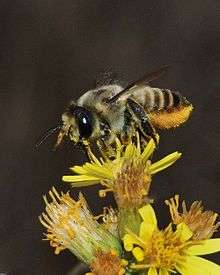Megachile
| Megachile | |
|---|---|
 | |
| Megachile lagopoda | |
| Scientific classification | |
| Kingdom: | Animalia |
| Phylum: | Arthropoda |
| Subphylum: | Hexapoda |
| Class: | Insecta |
| Order: | Hymenoptera |
| Suborder: | Apocrita |
| Superfamily: | Apoidea |
| Family: | Megachilidae |
| Subfamily: | Megachilinae |
| Tribe: | Megachilini |
| Genus: | Megachile Latreille, 1802 |
| Subgenera | |
The genus Megachile is a cosmopolitan group of solitary bees, often called leafcutter bees or leafcutting bees. While other genera within the family Megachilidae may chew leaves or petals into fragments to build their nests, certain species within Megachile neatly cut pieces of leaves or petals, hence their common name. This is one of the largest genera of bees, with almost 1500 species[1] in over 50 subgenera. North America has many native Megachile species. The introduced alfalfa leafcutter bee (Megachile rotundata) is managed for crop pollination.
Ecology

Nests are sometimes constructed within hollow twigs or other similarly constricted natural cavities, but often are in burrows in the ground. Nests are typically composed of single long columns of cells, the cells being sequentially constructed from the deepest portion of the tunnel outwards. The female places an egg in each cell with a supply of food, generally pollen, sometimes mixed with nectar. She builds a cap and walls off the cell. The larva hatches from the egg and consumes the food supply. After moulting a few times, it spins a cocoon and pupates, often after several months of hibernation as a prepupa. It emerges from the nest as an adult. Males, which are typically smaller and emerge in advance of females, die shortly after mating, but females survive for another few weeks, during which time they build new nests. Numerous families of wasps and bees parasitize Megachile nests, including Gasteruptiidae, Leucospidae, Sapygidae, and various cleptoparasitic megachilids, such as the closely related genus Coelioxys. Megachile rotundata and Megachile campanulae are among of the first insects documented in scientific literature to use synthetic materials for making nests.[2]

Many Megachile species use cut leaves to line the cells of their nests. It is thought that the leaf discs help prevent the desiccation of the larva's food supply.[1] Various species in the genus, especially those in the subgenus Chalicodoma and related groups, do not use cut leaves to line the cells, but instead use fairly dry plant resin, which they carry in their mandibles. The subgenus Chalicodoma includes the world's largest bee, Megachile pluto, as well as one of the largest megachilids in the United States, the recently introduced Asian species, Megachile sculpturalis.
Megachile species have no lobe (arolia) between their claws, thus are unable to climb smooth walls or glass.
Diversity
The genus Megachile contains 50 subgenera with nearly 1500 recognized species.[1] See also the list of Megachile species.
Notable subgenera:
Notable species:
- Megachile albisecta (Klug, 1817)
- Megachile campanulae, bellflower resin bee
- Megachile fidelis, faithful leafcutting bee
- Megachile perihirta, western leafcutting bee
- Megachile pluto, the largest bee in the world
- Megachile rotundata, alfalfa leafcutter bee
- Megachile rubi
- Megachile sculpturalis, giant resin bee
- Megachile texana
Gallery
| Wikispecies has information related to: Megachile |
| Wikimedia Commons has media related to Megachile. |
_from_Badlands_National_Park%2C_South_Dakota_-_USGS_Bee_Inventory_and_Monitoring_Laboratory.jpg)

 Megachile centuncularis cutting a leaf
Megachile centuncularis cutting a leaf Megachile sp. with cut leaf
Megachile sp. with cut leaf- Leaves cut by Megachile sp.
 Shelter built for Megachile
Shelter built for Megachile
References
- 1 2 3 Wedmann, S., et al. (2009). Direct and indirect fossil records of megachilid bees from the Paleogene of Central Europe (Hymenoptera: Megachilidae). Naturwissenschaften 96(6), 703-12.
- ↑ MacIvor, J Scott; Moore, Andrew E. (31 December 2013). "Bees collect polyurethane and polyethylene plastics as novel nest materials.". Ecosphere. 4 (12). doi:10.1890/ES13-00308.1. Retrieved 21 September 2014.
External links
- Megachile Identification Guide (female) discoverlife.org
- Megachile Identification Guide (male) discoverlife.org
- List of Species discoverlife.org
- Worldwide Species Map discoverlife.org